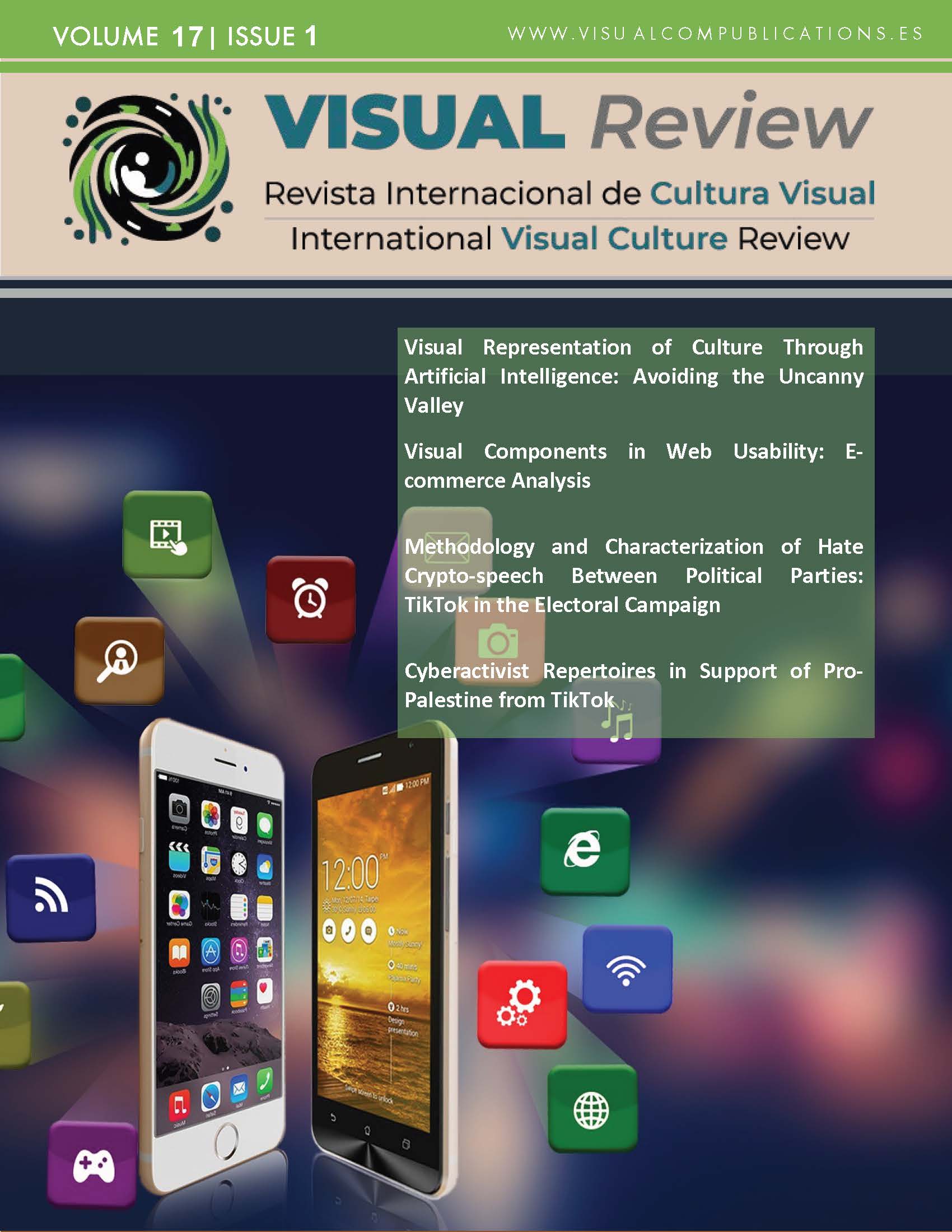Methodology and Characterization of Hate Crypto-Speech Between Political Parties
TikTok in the Electoral Campaign
DOI:
https://doi.org/10.62161/revvisual.v17.5309Keywords:
Hate speech, Hate, Crypto-discourse, Election campaigns, Political polarization, Political communication, TikTokAbstract
This article aims to analyze the possible hate speech used by political parties (PSOE, PP, Vox, Unidas Podemos, and Ciudadanos) on TikTok during the campaign for the May 28, 2023 elections, and to define common characteristics of such content, introducing the term "cryptic hate speech." The methodology includes content and discourse analyses of the parties' messages. Results indicate differing behaviors between the opposition and the government, with recurring themes based on the issuing party. Nationalism emerged as the most shocking and debated topic. Furthermore, Vox is identified as the party most involved in making hate speech towards fellow parliamentarians that is not perceived by the platforms nor by the authorities, which is identified as crypto-hate speech.
Downloads
Global Statistics ℹ️
|
461
Views
|
172
Downloads
|
|
633
Total
|
|
References
Argintzona, J. (2020, 5 de marzo). Cómo ha evolucionado TikTok en España y Latinoamérica. Digimind. bit.ly/3XeIjBc
Ballesteros Herencia, C. A. (2020). La propagación digital del coronavirus: Midiendo el engagement del entretenimiento en la red social emergente TikTok. Revista española de comunicación en salud, 171-185. https://doi.org/10.20318/recs.2020.5459 DOI: https://doi.org/10.20318/recs.2020.5459
Berdón-Prieto, P., Herrero-Izquierdo, J. y Reguero-Sanz, I. (2023). Political polarization and politainment: Methodology for analyzing crypto hate speech on TikTok. Profesional de la información, 32. https://doi.org/10.3145/epi.2023.nov.01 DOI: https://doi.org/10.3145/epi.2023.nov.01
Beriain Bañares, A.B., Crisóstomo Gálvez, R. y Chiva Molina, I.P. (2021). Comunicación política en España: representación e impacto en redes sociales de los partidos en campaña. Revista Mexicana De Ciencias Políticas Y Sociales, 67(244). https://doi.org/10.22201/fcpys.2448492xe.2022.244.75881 DOI: https://doi.org/10.22201/fcpys.2448492xe.2022.244.75881
Cáceres-Zapatero, M.D., Brändle, G. & Paz-Rebollo, M.A. (2023). Stances on hate speech: Population opinions and attitudes. Profesional de la información, 32(4). https://doi.org/10.3145/epi.2023.jul.10 DOI: https://doi.org/10.3145/epi.2023.jul.10
Calvo, D., López-García, G. y Sánchez-Duarte, J.M. (Eds.). (2023). Ciudadanía, comunicación y pandemia. Respuestas digitales a la crisis de la Covid-19. Publications Universidad de Valencia.
Casero-Ripollés, A., Ortells-Badenes, S. y Rosique, G. (2014). La espectacularización de la política. Consecuencias democráticas de la disolución de las fronteras entre información, entretenimiento y privacidad en la era digital. Telos: Cuadernos de comunicación e innovación, (99), 45-54. https://bit.ly/45m2jnl
Cervi, L., Tejedor, S. y Marín Lladó, C. (2021). TikTok and the new language of political communication: the case of Podemos. Cultura, Lenguaje y Representación, 26, 267-287. http://dx.doi.org/10.6035/clr.5817 DOI: https://doi.org/10.6035/clr.5817
Chaves-Montero, A., Gadea-Aiello, W.F., y Aguaded-Gómez, J.I. (2017). La comunicación política en las redes sociales durante la campaña electoral de 2015 en España: uso, efectividad y alcance. Perspectivas de la Comunicación, 10, 1. 55-83. https://bit.ly/3VvQmrL
Cinelli, M., De Francisci Morales, G., Galeazzi, A., Quattrociocchi, W. y Starnini, M. (2021). The echo chamber effect on social media. Proceedings of the National Academy of Sciences. 118(9). https://doi.org/10.1073/pnas.2023301118 DOI: https://doi.org/10.1073/pnas.2023301118
Cotarelo, R. (coord.). (2013). Ciberpolítica. Las nuevas formas de acción y comunicación políticas. Tirant Humanidades.
Cuevas-Calderón, E., Dongo, E. Y. y Kanashiro, L. (2022). Conservadores en TikTok: polarización social en el Perú. Prisma Social: revista de investigación social, 39, 156-182. https://bit.ly/4aQVfAj
De Lázaro, G. (2018). ¿Parlamentarismo sin mayorías o parlamentarismo «sin Gobierno»? Revista de Estudios Políticos, 182. https://doi.org/10.18042/cepc/rep.182.05 DOI: https://doi.org/10.18042/cepc/rep.182.05
Engesser, S., Ernst, Nicole; E. F. y Büchel, F. (2017). Populism and social media: How politicians spread a fragmented ideology. Information, Communication & Society, 20(8), 1109-1126. https://doi.org/10.1080/1369118X.2016.1207697 DOI: https://doi.org/10.1080/1369118X.2016.1207697
Gallardo-Paúls, B. y Enguix Oliver, S. (2016). Pseudopolítica: el discurso político en las redes sociales. Universidad de Valencia.
Gamir-Ríos, J y Sánchez-Castillo, S. (2022). La irrupción política del vídeo corto. ¿Es TikTok una nueva ventana para los partidos españoles? Communication & Society, 35 (2). 37-52. https://doi.org/10.15581/003.35.2.37-52 DOI: https://doi.org/10.15581/003.35.2.37-52
Gil-Ramírez M. y Gómez de Travesero-Rojas, R. (2020). Generación Z y consumo de información política: Entre la televisión y los nuevos formatos mediáticos. Ámbitos. Revista Internacional de Comunicación, 50 .62-79. https://doi.org/10.12795/Ambitos.2020.i50.05 DOI: https://doi.org/10.12795/Ambitos.2020.i50.05
Gitari, N. D., Zuping, Z., Damien, H. y Long, J. (2015). A lexicon-based approach for hate speech detection. International Journal of Multimedia and Ubiquitous Engineering, 10(4), 215–230. https://bit.ly/4b88UTT DOI: https://doi.org/10.14257/ijmue.2015.10.4.21
Gómez de Travesedo-Rojas, R., Gil-Ramírez, M. y Chamizo-Sánchez, R. (2023). Comunicación política en TikTok: Podemos y VOX a través de los vídeos cortos. Ámbitos: Revista Internacional de Comunicación, 60, 71-93. https://doi.org/10.12795/Ambitos.2023.i60.04 DOI: https://doi.org/10.12795/Ambitos.2023.i60.04
Gómez-García, S., Paz-Rebollo, M.A. y Cabeza-San-Deogracias, J. (2021). Newsgames against hate speech in the refugee crisis. Comunicar, 67, 123-133. https://doi.org/10.3916/C67-2021-10 DOI: https://doi.org/10.3916/C67-2021-10
Herrero-Izquierdo, J., Reguero-Sanz, I., Berdón-Prieto, P. y Martín Jiménez, V. (2022). La estrategia del odio: polarización y enfrentamiento partidista en Twitter durante las elecciones a la Asamblea de Madrid de 2021. Prisma Social: revista de investigación social, (39), 183-212. https://bit.ly/3XaX7Ra
Iyengar, S., Sood, G. y Lelkes, Y. (2012). Affect, not ideology: A social identity perspective on polarization. Public Opinion Quarterly, 76(3), 4. https://doi.org/10.1093/poq/nfs038 DOI: https://doi.org/10.1093/poq/nfs038
Literat, I., Kligler-Vilenchik, N. (2021). How popular culture prompts youth collective political expression and cross-cutting political talk on social media: a cross-platform analysis. Social Media + Society, 7(2). https://doi.org/10.1177/20563051211008821 DOI: https://doi.org/10.1177/20563051211008821
Logrieco, G., Marchili, M.R., Roversi, M. y Villani, A. (2021). The paradox of TikTok anti-pro-anorexia videos: How social media can promote non-suicidal self-injury and anorexia. International Journal of Environmental Research and Public Health, 18(3). 1–4. https://doi.org/10.3390/IJERPH18031041 DOI: https://doi.org/10.3390/ijerph18031041
March, E. y Marrington, J. (2019). A qualitative analysis of internet trolling. Cyberpsychology, behavior, and social networking, 22(3). 192-197. http://doi.org/10.1089/cyber.2018.0210 DOI: https://doi.org/10.1089/cyber.2018.0210
Mazzoleni, G. (2010). Comunicación política. Alianza.
Miller, L (2020). La polarización política en España: entre ideologías y sentimientos. PAPELES de relaciones ecosociales y cambio global, 152, 13-22. https://bit.ly/4caskrT
Miró Llinares, F. (2016). Taxonomía de la comunicación violenta y el discurso del odio en Internet. Revista de Internet, Derecho y Política, 22. 93-118. http://dx.doi.org/10.7238/idp.v0i22.2975 DOI: https://doi.org/10.7238/idp.v0i22.2975
Nieto-Jiménez, J. C. (2022). Fragmentación y polarización parlamentarias en las Cortes Generales españolas (2015-2019). Revista de Estudios Políticos, 196. 159-192. https://doi.org/10.18042/cepc/rep.196.06 DOI: https://doi.org/10.18042/cepc/rep.196.06
Noriega, Chon A. e Iribarren, F.J. (2012). Social Networks for Hate Speech: Commercial Talk Radio and New Media. UCLA Chicano Studies, 2. https://bit.ly/4cbsKhE
Ortega, R.Y., Nieto, F., Dorantes, R. y Sotomayor, C. (2022). Polarización estratégica en redes sociales. El Colegio de México. Centro de Estudios Internacionales.
Salminen, J., Veronesi, F., Almerekhi, H., Jung, S.G.y Jansen, B.J. (2018). Online hate interpretation varies by country, but more by individual: a statistical analysis using crowdsourced ratings. En Fifth international conference on social networks analysis. Management and security (Snams). 88-94. https://doi.org/10.1109/SNAMS.2018.8554954 DOI: https://doi.org/10.1109/SNAMS.2018.8554954
Tajadura, J. (2022). Los partidos políticos, la cultura política democrática y las reglas no escritas del réigmen parlamentario. En Ignacio Gutiérrez y María Salvador Martínez (Eds). División de poderes en el Estado de partidos. Marcial Pons.
Van Dijk, T. A. (2002). Discourse and racism. En D. T. Goldberg & J. Solomos (Eds.), A Companion to Racial and Ethnic Studies. Blackwell.
Vintimilla-León, D. E. y Torres-Toukoumidis, Á. (2021). Covid-19 y TikTok. Análisis de la Folksonomía social. Revista Ibérica de Sistemas e Tecnologias de Información 40, 15-26. https://bit.ly/4bK3ak6
Watanabe, H., Bouazizi, M. y Ohtsuki, T. (2018). Hate Speech on Twitter: A Pragmatic Approach to Collect Hateful and Offensive Expressions and Perform Hate Speech Detection. IEEE Access, 6, 13825–13835. https://bit.ly/4ebNkjM DOI: https://doi.org/10.1109/ACCESS.2018.2806394
Weimann, G. y Masri, N. (2020). Research Note: Spreading Hate on TikTok. Studies in Conflict and Terrorism, 1. 1-14. https://doi.org/10.1080/1057610X.2020.1780027 DOI: https://doi.org/10.1080/1057610X.2020.1780027
Wheatstone, R. y O’Connor, C. (2020, Marzo 1). Cesspit of Hate. Tiktok swamped with sickening videos of terror attacks muders, Holocaust denials and vile racist slurs. The Sun. https://bit.ly/45cGlDi
Wolley, S. C. y Howard, P. N. (Eds.). (2018). Computational Propaganda: Political Parties, Politicians and Political Manipulation on Social Media. Oxford University Press
Downloads
Published
How to Cite
Issue
Section
License
Copyright (c) 2025 VISUAL REVIEW. International Visual Culture Review / Revista Internacional de Cultura Visual

This work is licensed under a Creative Commons Attribution-NoDerivatives 4.0 International License.
Those authors who publish in this journal accept the following terms:
-
Authors retain copyright.
-
Authors transfer to the journal the right of first publication. The journal also owns the publishing rights.
-
All published contents are governed by an Attribution-NoDerivatives 4.0 International License.
Access the informative version and legal text of the license. By virtue of this, third parties are allowed to use what is published as long as they mention the authorship of the work and the first publication in this journal. If you transform the material, you may not distribute the modified work. -
Authors may make other independent and additional contractual arrangements for non-exclusive distribution of the version of the article published in this journal (e.g., inclusion in an institutional repository or publication in a book) as long as they clearly indicate that the work was first published in this journal.
- Authors are allowed and recommended to publish their work on the Internet (for example on institutional and personal websites), following the publication of, and referencing the journal, as this could lead to constructive exchanges and a more extensive and quick circulation of published works (see The Effect of Open Access).













